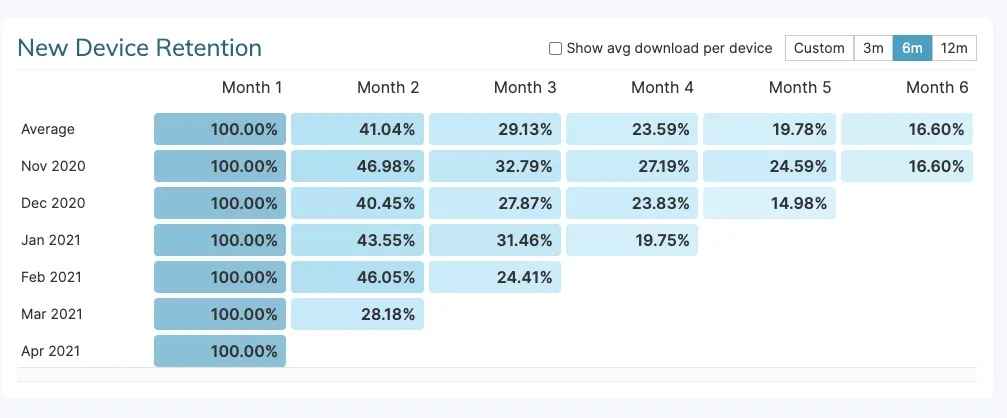How sticky is your content?

A Q&A with Chartable’s co-founder and CEO Dave Zohrob
This new feature on Chartable aims to analyze if your podcast listeners are coming back to you for more
At Pacific Content, my role as a podcast measurement analyst is primarily to educate; I inform our clients on best practices for measuring the success of their shows.
Unfortunately, the wealth of data available for analyzing the use of digital media doesn’t yet extend to the realm of podcasts. And, even though it is not uncommon for podcast hosts to ask listeners to “like, share, follow, and subscribe”, the reality is that when it comes to tracking those subscribers and followers, our clients are often surprised to learn there is no single source — or even single definition — for “subscribers” across platforms, as my colleague, Dan Misener, has previously explained in “Beyond the Download.”
This puts me in a tough spot, as I want to provide as much (relevant) information as possible to our clients! Needless to say, I get excited when a measurement partner is able to give me access to tools for measuring podcast listening in a new way.
When we saw that Chartable had done just that — launch a tool for tracking unique listener downloads month-over-month — I felt it was worth getting a little more insight into what this added feature can really do. so I reached out to Dave Zohrob, co-founder at Chartable, for answers to a few of my questions:
Matt Hird: What prompted you to add month-over-month download retention metrics to Chartable’s mix of reporting tools?

Dave Zohrob: Our background is in web and mobile startups, where these metrics are super-common. It surprised us that nobody had built this for podcasters! Retention is a super-important metric for anyone looking to build their audience over time.
M.H.: Who in the industry is going to be getting the most out of this tool, and what do you expect to see as the typical use cases?
D.Z.: Podcasters big and small will be able to get a sense of whether they’re improving their content over time. We think the tool can answer some common questions:
- Are listeners coming back to my show? Is that trend improving?
- Did the listeners I acquired through my most recent marketing campaign stick around?
- How do my different shows compare to each other?
M.H.: I’m already excited to get digging into the data for interest’s sake alone, but for the users who aren’t data nerds, what value will the reports serve for producers and marketers? What kind of editorial or marketing decisions is this new tool going to help them make?
D.Z.: From an editorial perspective, one can look at trends to see if any particular guests or episodes, or content styles influenced long-term retention. For example, if you had a big celebrity guest come on and that episode performed two-times your baseline, did any of those listeners stick around [for subsequent episodes]? If they did, it’s probably worth pursuing more guests like that.
From a marketing standpoint, you can look at high-level trends in your new listener retention and compare [them] to the campaigns you’re running. Are your social media efforts paying off? If you’re running a big audio campaign this month, will those listeners stick around?
M.H.: Typically, you need three months of data to start reporting on retention, but I’m impatient. Why do I need to wait?
D.Z.: Without some history, there’s nothing to compare! Our calculation is based on calendar months — it would be noisy to do it with shorter periods, and it’s somewhat complex to calculate, so we wanted to launch an initial simplified version. We hope to improve it over time.

M.H.: What should I consider a ‘good’ rate of retention? Are there any plans for introducing aggregated benchmarks?
D.Z.: This is a common question and we’re working on benchmarks right now! “Good” retention depends on the kind of show and its release frequency. We’ll have more to share soon!
M.H.: Understanding this is a new system, have you seen any underlying trends? Does seasonality play into retention? Do people drop off over Christmas or summer break? Does the number of episodes/month impact retention?
D.Z.: Retention metrics haven’t been around long enough for us to pull out seasonal trends yet — and because we’re looking at calendar months, unless you stop publishing in December you should still see good data for that month.
M.H.:The Interactive Advertising Bureau’s (IAB) definition of a “listener” (or “unique user”) is based on the IP address and user-agent. Both of these can change over time. How do Chartable’s retention metrics deal with the volatility of IP addresses and UA strings over longer periods of time?
D.Z.: Because we get so little data relative to other digital media, we have to be a bit creative to make our dashboard useful. We’re currently taking several measures to give a better sense of true listener behavior — we currently focus on household IP addresses, and we exclude user-agents that change frequently (like browsers) and focus on the actual players, like Apple Podcasts. We additionally filter activity on IP addresses which we deem to be “noisy” — i.e. addresses which may not stay static over time. This helps give a trendline that’s closer to “true” behavior.
I’m excited for what insights this tool is going to facilitate in the months to come. On the reporting side, I can see it adding another way to evaluate the longer-term effectiveness of marketing campaigns, and to Dave’s point, to see if certain guests get listeners hooked on more episodes. With enough data, it might even be useful on the publishing side: seasonal trends in month-to-month retention could inform episode release schedules, aligning them with the stickiest months of the year.
Sign up for the Pacific Content Newsletter: audio strategy, analysis, and insight in your inbox.
